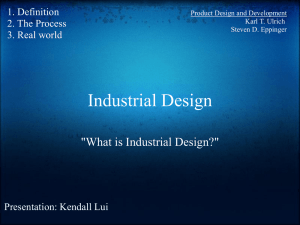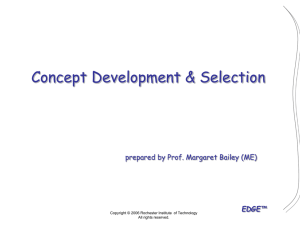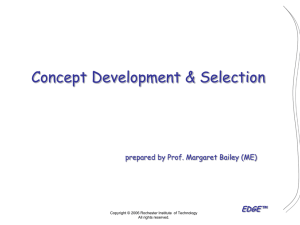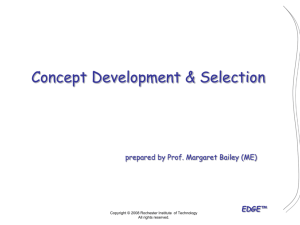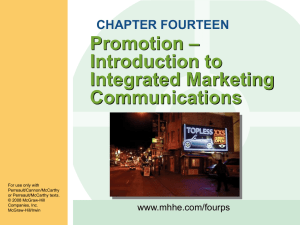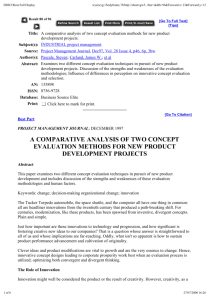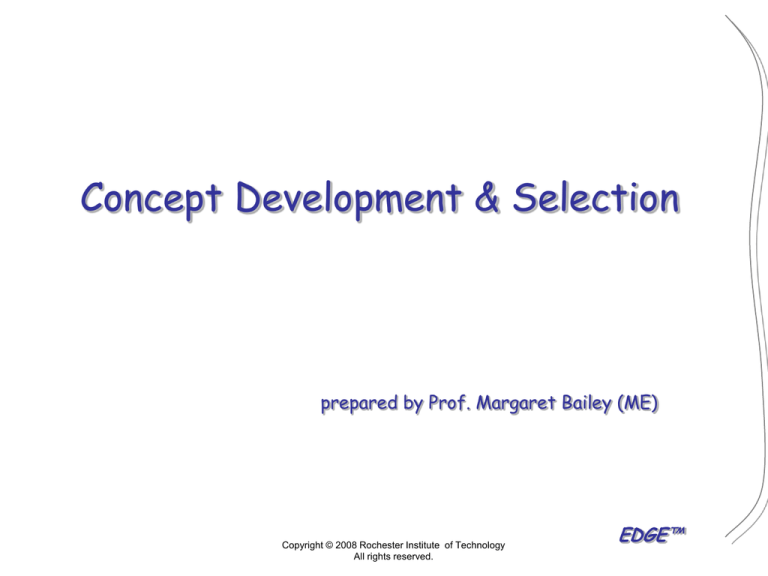
Concept Development & Selection
prepared by Prof. Margaret Bailey (ME)
Copyright © 2008 Rochester Institute of Technology
All rights reserved.
EDGE™
Session Overview
• Introduce Concept Development &
Selection Process
• Explore Two-Stage Methodology
• Demonstrate Above Steps on Example
• Discuss Common Dysfunctions Associated
with this Phase
• Apply Concept Development & Selection
Process to Team MSD I Project
EDGE™
Concept Development & Selection Process
Mission
Statement
Identify
Customer
Needs
Establish
Target
Specifications
Generate
Product
Concepts
Select
Product
Concept(s)
Test
Product
Concept(s)
Set
Final
Specifications
Plan
Downstream
Development
Development
Plan
Perform Economic Analysis
Benchmark Competitive Products
Build and Test Models and Prototypes
These activities can occur
throughout the design
process!
Karl T. Ulrich and Steven D. Eppinger, 2008, Product Design and
Development, Exhibit 7-2, Chapter 7, 4th Edition, p. 125, Irwin McGraw-Hill
EDGE™
Concept Development &
Selection Process
Concepts
Scoring
Stage
Selection Criteria
Screening
Stage
Concept Ratings
Winning Concept(s)
Goal: The goal is not to select the best
concept but to develop the best concept
by combining and/or refining
EDGE™
Concept Development & Selection
Funnel
concept gener ation
concept screeni ng
concept scor ing
concept testi ng
Karl T. Ulrich and Steven D. Eppinger, 2008, Product Design and Development,
Exhibit 7-4, Chapter 7, 4th Edition, p. 128, Irwin McGraw-Hill
EDGE™
Concept Selection Process
Screening Stage
Prepare the Matrix
Rate Concepts
Rank Concepts
Combine and Improve
Select Best Concept
Reflect on the Process
Scoring Stage
Prepare the Matrix
Rate Concepts
Rank Concepts
Combine and Improve
Select Best Concept
Reflect on the Process
EDGE™
Concept Selection Example:
Reusable Syringe
Karl T. Ulrich and Steven D. Eppinger, 2008, Product Design and
Development, Exhibit 7-1, Chapter 7, 4th Edition, p. 123, Irwin McGraw-Hill
EDGE™
Concept Selection Example:
Reusable Syringe
• Design an improved, reusable syringe with
precise dosage control for outpatient use.
– Current product was too costly and inaccurate
• Seven criteria identified based on customer
needs
– Ease of handling, use and manufacture
– Readability of dose settings and accuracy
– Durability and portability
• Seven overall product concepts proposed
(Exhibit 7-3, pp. 126-127)
EDGE™
Concept Development & Selection
Funnel
concept gener ation
concept screeni ng
concept scor ing
concept testi ng
Karl T. Ulrich and Steven D. Eppinger, 2008, Product Design and
Development, Exhibit 7-4, Chapter 7, 4th Edition, p. 128, Irwin McGraw-Hill
EDGE™
Screening Stage
Concepts which made the first cut
• Prepare the Matrix – Pugh's
METHOD
– Criteria
– Select Reference Concept
• Rate Concepts
– Scale (+ – 0)
– Compare to Reference
Concept
• Rank Concepts
• Combine and Improve
– Remove Bad Features
– Combine Good Qualities
• Select Best Concepts
– May Be More than One
– Beware of Average Concepts
• Reflect on the Process
– Continuous Improvement
Karl T. Ulrich and Steven D. Eppinger, 2008, Product Design and Development,
Exhibits 7-3 and 7-5, Chapter 7, 4th Edition, pp. 126 & 130, Irwin McGraw-Hill
EDGE™
Examples of Concept Generation
Karl T. Ulrich and Steven D. Eppinger, 2008,
Product Design and Development, Exhibit 7-3,
Chapter 7, 4th Edition, p. 126, Irwin McGraw-Hill
Concepts need to be well-defined
PRIOR to concept evaluation!
(neither of these concepts made
the screening cut) EDGE™
Determine Criteria and Reference
Concept
• In teams begin
preparing the Matrix –
Pugh's METHOD
– Establish a preliminary list of
the subsystems which will
involve a matrix for concept
selection
– Determine Selection Criteria
for several of the above
subsystems
– Select a Reference Concept
for each matrix
EDGE™
Screening Stage
• Pugh's METHOD
– Criteria
– Select Reference Concept
Concepts which made the first
cut BUT more refinement
required before SCORING
process
• Rate Concepts
– Scale (+ – 0)
– Compare to Reference
Concept
• Rank Concepts
• Combine and Improve
– Remove Bad Features
– Combine Good Qualities
• Select Best Concepts
– May Be More than One
– Beware of Average Concepts
• Reflect on the Process
– Continuous Improvement
Karl T. Ulrich and Steven D. Eppinger, 2008, Product Design and Development,
Exhibits 7-3 and 7-5, Chapter 7, 4th Edition, pp. 126 & 130, Irwin McGraw-Hill
EDGE™
Identify “Winning” Concepts
Concept A has highest net
score and no “worse than”
ratings
Karl T. Ulrich and Steven D. Eppinger, 2008, Product Design and Development,
Exhibit 7-3, Chapter 7, 4th Edition, p. 126, Irwin McGraw-Hill
EDGE™
Combine Winning Concepts
Concepts D & F were
combined to eliminate
“worse than” ratings
Karl T. Ulrich and Steven D. Eppinger, 2008, Product Design and Development,
Exhibit 7-3 & 7-6, Chapter 7, 4th Edition, pp. 127 & 133, Irwin McGraw-Hill
EDGE™
Refine Winning Concepts
Concept G’s scored well but
ease of handling was a
problem, therefore revise!
Karl T. Ulrich and Steven D. Eppinger, 2008, Product Design and Development,
Exhibit 7-3 & 7-6, Chapter 7, 4th Edition, pp. 127 & 133, Irwin McGraw-Hill
EDGE™
Screening Stage for MSD I Project
• In teams
– Prepare the Concept Screening Matrix (Exhibit 7-5,
p. 130)
– Begin the following (and finish today!):
• Rate and Rank Concepts
• Combine and Revise
• Select Best Concept(s)
• Proceed onto Concept Scoring Process
EDGE™
Concept Development & Selection
Funnel
concept gener ation
concept screeni ng
concept scor ing
concept testi ng
Karl T. Ulrich and Steven D. Eppinger, 2008, Product Design and
Development, Exhibit 7-4, Chapter 7, 4th Edition, p. 128, Irwin McGraw-Hill
EDGE™
Scoring Stage
•
REFINE Pugh’s Matrix
•
Rate Concepts
•
Rank Concepts
•
Combine and Improve
•
Select Best Concepts
•
Reflect on the Process
– Criteria
– ADD Weightings
– REFINE Scale (1 - 5)
– Select “Average” Criteria for
Reference
– Compare to Reference Criteria
– Sum Weighted Scores
– Remove Bad Features
– Combine Good Qualities
– May Be More than One
– Continuous Improvement
Karl T. Ulrich and Steven D. Eppinger, 2008, Product Design and
Development, Exhibit 7-7, Chapter 7, 4th Edition, p. 134, Irwin McGraw-Hill
EDGE™
Generated from
Customer Needs
– week 1
Example: Concept Scoring
Concepts
A
(reference)
Master Cylinder
DF
E
G+
Lev er Stop
Swash Ring
Dial Screw+
Selection Criteria
Weight
Rating
Weighted
Score
Rating
Weighted
Score
Rating
Weighted
Score
Rating
Weighted
Score
Ease of Handling
5%
3
0.15
3
0.15
4
0.2
4
0.2
Ease of Use
15%
3
0.45
4
0.6
4
0.6
3
0.45
Readability of Settings
10%
2
0.2
3
0.3
5
0.5
5
0.5
Dose Metering Accuracy
25%
3
0.75
3
0.75
2
0.5
3
0.75
Durability
15%
2
0.3
5
0.75
4
0.6
3
0.45
Ease of Manufacture
20%
3
0.6
3
0.6
2
0.4
2
0.4
Portability
10%
3
0.3
3
0.3
3
0.3
3
0.3
T otal Score
Rank
Continue?
2.75
3.45
3.10
3.05
4
1
2
3
No
Develop
No
No
Need to revisit PUGH Matrix as your
team’s knowledge base expands
EDGE™
Karl T. Ulrich and Steven D. Eppinger, 2008, Product Design and
Development, Exhibit 7-7, Chapter 7, 4th Edition, p. 134, Irwin McGraw-Hill
Final Winning Concept - DF
Concept DF was selected as the winning concept HOWEVER:
Do not simply select concept was highest rating – conduct a
sensitivity study by varying weights and ratings and examine
effect on winning concept rating. Does uncertainty about a
particular value have a large impact on the winning concept?
Team could have decided to go with top two (or more) concepts.
Concepts could be prototyped and tested for customer feedback.
EDGE™
Karl T. Ulrich and Steven D. Eppinger, 2008, Product Design and Development,
Exhibit 7-6, Chapter 7, 4th Edition, p. 133, Irwin McGraw-Hill
Tips for Concept Development & Selection
• When possible, use objective rather
subjective criteria
• Useful to identify strengths of concepts that
do not make it through screening/scoring
stages – could these be incorporated on
winning concept(s)?
• Include ease of manufacture, reduced
liability, and/or cost as criteria
• Use concept development & selection process
throughout MSD I and MSD II
EDGE™
Concept Development & Selection
Funnel
concept gener ation
concept screeni ng
concept scor ing
concept testi ng
Karl T. Ulrich and Steven D. Eppinger, 2008, Product Design and
Development, Exhibit 7-4, Chapter 7, 4th Edition, p. 128, Irwin McGraw-Hill
EDGE™
Test Product Concepts
Mission
Statement
Identify
Customer
Needs
Establish
Target
Specifications
Generate
Product
Concepts
Select
Product
Concept(s)
Test
Product
Concept(s)
Set
Final
Specifications
Plan
Downstream
Development
Development
Plan
Perform Economic Analysis
Benchmark Competitive Products
Build and Test Models and Prototypes
Helps in further exploring concepts…
Which concept should be pursued?
How can the concept be improved to better meet customer needs?
Should development continue?
TOOL: Survey customer response, refer to Chapter 8 for more details
Karl T. Ulrich and Steven D. Eppinger, 2008, Product Design and Development,
Exhibit 8-2, Chapter 8, 4th Edition, p. 146, Irwin McGraw-Hill
EDGE™
Practice Concept Development &
Selection on MSD I Project
• Continue Team Screening Stage and start
Scoring Stage
Screening and
Scoring Stages
Prepare/Refine the Matrix
Rate Concepts
Rank Concepts
Combine and Improve
Select Best Concept
Reflect on the Process
Sample Excel
Spreadsheet
Available for
PUGH
EDGE™
Next Steps….
• Start with Concepts Associated with Critical Sub-function(s)
– Develop Pugh's Matrix for SCREENING Process
• Create Criteria, Select Reference Concept, Rate Concepts
(Scale (+ – 0)), Compare to Reference Concepts, Rank Concepts,
• Combine and Improve, Remove Bad Features, Combine Good
Qualities, Select Best Concepts
• Refer to Exhibit 7-5
– Refine Pugh's Matrix during SCORING Process
• Refine Criteria, ADD Weightings, Rate Concepts (Scale (1 - 5)),
Select “Average” Criteria for Reference, Determine Sum
Weighted Scores
• Combine and Improve, Remove Bad Features, Combine Good
Qualities, Select Best Concepts
• Refer to Exhibit 7-7
– Get customer feedback, if possible
EDGE™

